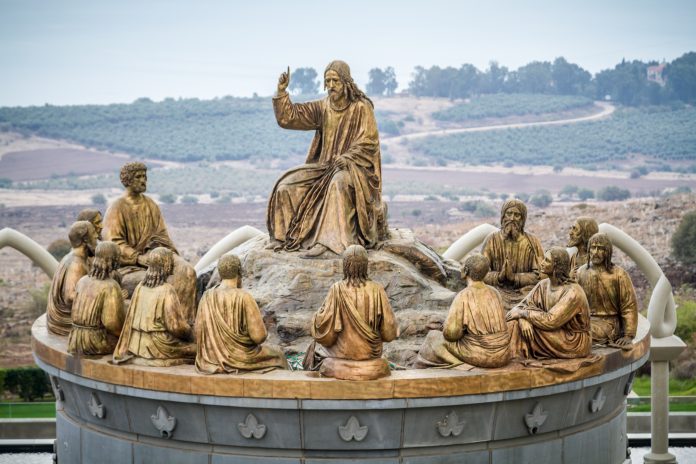
by Kate Ristow
See the end of this article for a worksheet to help children reflect on their service experiences.
We are born selfish. Psychologists call it “egocentricity,” and it’s a good thing. It enables infants to get their needs met—for hunger to be satisfied, for thirst to be slaked. We cry and are comforted or changed or swaddled. Our wails summon a smiling face or a soothing voice.
As babies, we see the world only from our own points of view. As we grow and mature, we find that others in the world have needs and desires as well. Over many years and interactions, we learn about caring and sharing.
This process includes instruction, example, trial and error, observation, practice, and even the occasional “time out.” For those of us lucky enough to be raised in a faith tradition, catechesis contributes greatly to our understanding that God calls us to love and care for others. Gradually we strive to move from selfishness to selflessness. In catechetical terms, this process is called “conversion.”
The Tradition of Almsgiving
During Lent, we prepare ourselves for Easter by renewing our commitment to live as disciples of Jesus so that we might share in Christ’s new life. One of the traditional practices we emphasize during this season is almsgiving.
Almsgiving comes from a Greek word that means “mercy” or “pity.” Although alms are usually considered material or tangible assistance to those in need, we also honor the tradition of almsgiving whenever we reach out to share our time, talent, and treasures with others.
During Lent, we fast—we give up things. Giving alms is a positive response to the physical sacrifice of fasting. Our virtuous living, good deeds, and love of neighbor are outward signs that we are all one Body—the Body of Christ. As St. Paul taught: “If one part (of the body) suffers, all the parts suffer with it; if one part is honored, all the parts share its joy” (1 Corinthians 12:26).
Almsgiving not only helps others; it also unites us with Jesus and helps us to share in his ministry. When we have a canned-food drive, we feed the hungry as Jesus did in Mark 6:34-44. When we make cards for hospitalized parishioners or pray for the sick, we reach out to people in need of healing as Jesus did in Matthew 9:18-36. Help your students appreciate that almsgiving is more about caring than money. Very often, the most costly element in giving alms is our gift of time.
Changing Perceptions
The classic New Testament example of almsgiving is described as the “Communal Life” in the Acts of the Apostles 2:42-45. Yet, this distribution of goods to those in need had nothing to do with Lent because the forty-day season we know as Lent was not established until the fourth century. Rather, the early Church had a constant concern for the poor. As the Church flourished, deacons were entrusted with the special responsibility of charitable outreach for the local Church communities.
We always want to help our kids plan and participate in charitable activities. However, if the only time we organize opportunities for students to reach out to others is during Lent, we send a mixed message.
First, it appears that we are helping others so that we can prepare for Easter. We make it about ourselves, not about those who need our help. Second, it tells our students that helping others once a year is enough. Is that the impression we want to give?
Let’s also look at the language we use to describe our charitable efforts. We plan service “projects.” Think about that. People who need our help are not “projects.” They are our brothers and sisters. In most cases, their needs do not disappear when our “project” is completed. Is there a term we can use to better describe activities that help to cultivate caring attitudes and efforts within our students?
The “Why” of Service
Clearly, we need to do a better job helping students see the connection between their service experiences and Jesus’ command to care for others. The best place to start is the Scriptures.
The Scripture stories listed below can be used with every age level to help students prepare for parish-based or off-site service activities. Each of these stories makes clear that we show our love for God through our service and care for others.
Read and discuss one or more of these Gospel accounts to help prepare students for service or to help them see the relationship between living as disciples of Jesus and serving others.
John 13:4-15—The Washing of the Disciples’ Feet
Mark 9:33-37—The Greatest in the Kingdom
Matthew 25:31-46—The Judgment of the Nations
Luke 10:29-37—The Parable of the Good Samaritan
Another way to reinforce why we are called to service is to emphasize the mission we receive at Baptism. Recall that when we are baptized and confirmed, we are anointed with the holy oil of chrism. This anointing strengthens us to take part in Christ’s work of Priest, Prophet, and King. We are given a share in Jesus’ mission of preparing the way for God’s kingdom of peace, justice, and love. We are called to live out our Baptism through service to the Church and the world. Help students begin to recognize that serving others means caring about and for people, as Jesus did. Emphasize that service includes both prayer and action.
Developing a Continuum of Care and Service
At a meeting, have catechists work together to create a chart of the service experiences your program currently provides for students in grades K through 8, what the experiences entail, how many service opportunities students participate in each year, and other pertinent details.
Then study the entire chart to determine the range of service experiences students are invited to participate in as they progress through your program. Look for gaps. Your goal should be to provide students with a wealth of experiences within the parish and in the larger community.
Also look for a diversity of experiences. While it’s great for students to interact with seniors, having third-, fifth-, and eighth-grade students visit residents in a nursing home may be too repetitive and prevent the kids from participating in other service areas.
After studying your current service program, brainstorm together to generate fresh ideas that help students show care for a variety of groups.
Resources
A Complete Guide to Service Learning by Cathryn Berger Kaye, MA (Minneapolis: Free Spirit Publishing, 2010) lists 13 areas that have potential for engaging kids in service opportunities at various ages: Animal Protection and Care; Elders; The Environment; Gardening; Healthy Lives and Healthy Choices; Hunger, Homelessness, and Poverty; Immigrants; Safe and Strong Communities; Social Change: Issues and Actions; Special Needs and Disabilities; AIDS Education and Awareness; and Emergency Readiness. This book is an excellent source of ideas. Those teaching full-time in a Catholic or public school will find multiple ideas in each chapter for making connections across the curriculum.
Another excellent resource is The Kid’s Guide to Service Projects by Barbara A. Lewis (Minneapolis: Free Spirit Publishing, 1995). Not only does this book provide over 500 workable service ideas for kids at different grade levels but it also offers many practical tips such as “Ten Steps to Successful Service Projects,” “How to Create a Petition,” “How to Support or Oppose a Law,” “Seven Ways to Fundraise,” and so much more.
Consider recruiting a service coordinator who will be responsible for planning two service opportunities for each grade level. The coordinator, usually a volunteer, can work with the catechists at each level to determine the students’ interests, make suggestions, and do the overall organization and long-range planning. In the weeks before the event, the catechists can then take a more active role.
Plan for Processing
Each time we participate in a service activity with our students, we need to take time to process the experience with them. Ideally, this discussion and reflection will take place immediately after each service experience.
You may want to have students write in their own ongoing Service Journal beginning in third grade. After each service activity—whether that activity be with the class, the family, or on their own—encourage students to write about their experiences: What did I learn? How did the experience affect me? What questions come to mind as a result of this experience? What else can I do to help others?
How wonderful it would be if kids could record their thoughts from year to year in the same notebook! Although storage is always a challenge, perhaps the journals could be collected at each grade level after the last service activity of the year and packed by grade level in banker’s boxes over the summer to be distributed to next year’s catechists before the year’s program begins. The Service Journals will be a concrete and lasting sign of the children’s commitment to respond to Jesus’ call to care for our brothers and sisters. Kids truly enjoy looking back at previous year’s comments and recalling the service experiences they had.
Saint Search
Saint Teresa of Ávila (1515-1582) wrote, “Christ has no body on earth but yours.” Have students use the internet to research how one or more of the following holy people—saints, blesseds, or venerables—continued Christ’s work by showing special care for others during their lives. These individuals are not as well-known as people like Blessed Mother Teresa of Calcutta, St. Francis of Assisi, or St. Elizabeth Ann Seton. Learning about them will broaden the students’ understanding of how we all are called to care for others.
For example, St. Robert Bellarmine, known for his great scholarship, showed his special concern for those who were poor in many ways. When moving into his lavish apartment in the Vatican so that he could work for the pope, Robert took down the expensive draperies and donated the fabric to clothe those who were poor. When asked about his empty walls, he laughed and told people not to worry. He said, “The walls won’t get cold.” Ask the children to find one concrete example of care for others in the life of the person they choose.
Saint Joan Delanoue Blessed Pier Giorgio Frassati
Saint Frances of Rome Saint Bridget of Sweden
Saint Maria Venegas Saint Vincent Pallotti
Venerable Catherine McAuley Saint Camillus
Venerable Pierre Toussaint Blessed Edmund Rice
Venenrable Solanus Casey Blessed Frances Schervier
Saint Marguerite d’Youville Blessed Giuseppina Bonino
Saint Robert Bellarmine Saint Jeanne Jugan
Showing Care in Prayer
* Make a Caring Chain. Invite students to make a link for people in need of prayer—those who are homeless, those who are suffering the results of natural disasters, or people they know who are sick or suffering. Place the connected links on your prayer table and encourage the kids to add to it during the year.
* Pray with Current Events. Divide the class into small groups and distribute newspapers and weekly news magazines to each group. Direct each group to find two people or groups in need of prayer and to work together to write a petition asking God to watch over and care for the people they identified.
* Write Personal Prayers. Following a service experience, encourage students to pray daily for the people they served. You might have them work in small groups to write their own personal prayers for those they served.
Kate Ristow, Contributing Editor toCATECHIST, has worked in Catholic publishing for over 25 years as a national speaker and writer, building on a wealth of experience in the religious formation of children and catechists in both parish and Catholic school programs.
Service Experience Worksheet
Use this worksheet [CLICK HERE] to help students reflect on their service experience. After students complete the worksheet independently, invite volunteers to share their responses with the group.
Copyright 2012, Bayard, Inc. All rights reserved. This article is protected by United States copyright and other intellectual property laws and may not be reproduced, rewritten, distributed, redisseminated, transmitted, displayed, published or broadcast, directly or indirectly, in any medium without the prior written permission of Bayard, Inc.
This article was written by the Catechist Staff and appeared in Catechist magazine, January 2012.
Image Credit: alefbet/Shutter Stock 559112293




